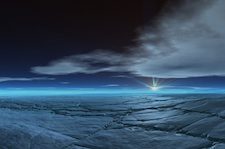 Analysis from the Oslo-based Arctic Monitoring and Assessment Programme (AMAP) shows the pace of climate change in the Arctic is quickening and will significantly contribute to sea level rise by up to five feet by the end of the century.
Analysis from the Oslo-based Arctic Monitoring and Assessment Programme (AMAP) shows the pace of climate change in the Arctic is quickening and will significantly contribute to sea level rise by up to five feet by the end of the century.
AMAP will release its full report in Nuuk Greenland at next week’s ministerial meeting of the eight-nation Arctic Council.
“The observed changes in sea ice on the Arctic Ocean, in the mass of the Greenland Ice Sheet and Arctic ice caps and glaciers over the past 10 years are dramatic and represent an obvious departure from the long-term patterns,” AMAP said in a press statement.
The Intergovernmental Panel on Climate Change (IPCC) projected a purposefully conservative estimate of 7 to 23 inches of sea level rise by the end of the century in their 2007 Fourth Assessment Report. The Assessment warned that a rapid increase in ice melt from Antarctica or the Greenland ice sheet (which the IPCCC did not attempt to project) would push sea levels dramatically higher.
Several studies since the 2007 Fourth Assessment have shown telltale signs of just that sort of accelerating ice melt, and now the latest AMAP analysis adds to the warning that change is accelerating and will cause significant sea level rise. But like the IPCCC Assessment, the AMAP report says determining the full extent of sea level rise remains and open question, saying that “high uncertainty surrounds estimates of future global sea level.”
Arctic warming double global average
The AMAP report describes the Arctic as a region undergoing rapid and accelerating change:
- The Arctic has warmed at twice the rate of the global average since 1980.
- Summer temperatures have been higher than at any time during the past 2,000 years.
- The past five years have had higher surface temperatures than any five-year period since modern weather record-keeping began in 1880.
- Snow cover and sea ice extent has decreased, while temperature of Arctic permafrost has increased by up to 3.6 degrees Fahrenheit in some areas.
The AMAP analysis also speaks of positive reinforcing feedbacks:
“There is now evidence that two components of the cryosphere — snow and sea ice — are interacting with the climate system to accelerate warming,” the report says.
With decreasing snow cover exposing the darker ground underneath, more heat is absorbed, causing increased melting. Similar reinforcing feedback is caused by decreased sea ice extent. As more open ocean is exposed, more heat is absorbed, accelerating the decrease in sea ice.
The AMAP reports projects a “nearly” ice-free Arctic within the 30 to 40 years.
Source:
ClimateWire (subscription required)
Related articles
- Arctic Affected by Climate Change More than Expected (planetsave.com)
- Report confirms Arctic melt accelerating (cbsnews.com)
- Climate Change Report Shows Arctic Melt Accelerating (alan.com)
- New report confirms Arctic melt accelerating (ctv.ca)
- Seas Could Rise Up to 1.6 meters by 2100 (scientificamerican.com)
- New Climate Report: Arctic Melt Accelerating (abcnews.go.com)



